Sunlight energy is key as we move towards solar power. The sun’s energy could power the world for a year in just 1.5 hours. This makes sunlight energy essential for our energy needs.
Solar power is a big player in renewable energy. It helps cut down greenhouse gas emissions and lowers carbon footprint. Using sunlight to make power is clean and efficient, a better choice than fossil fuels.
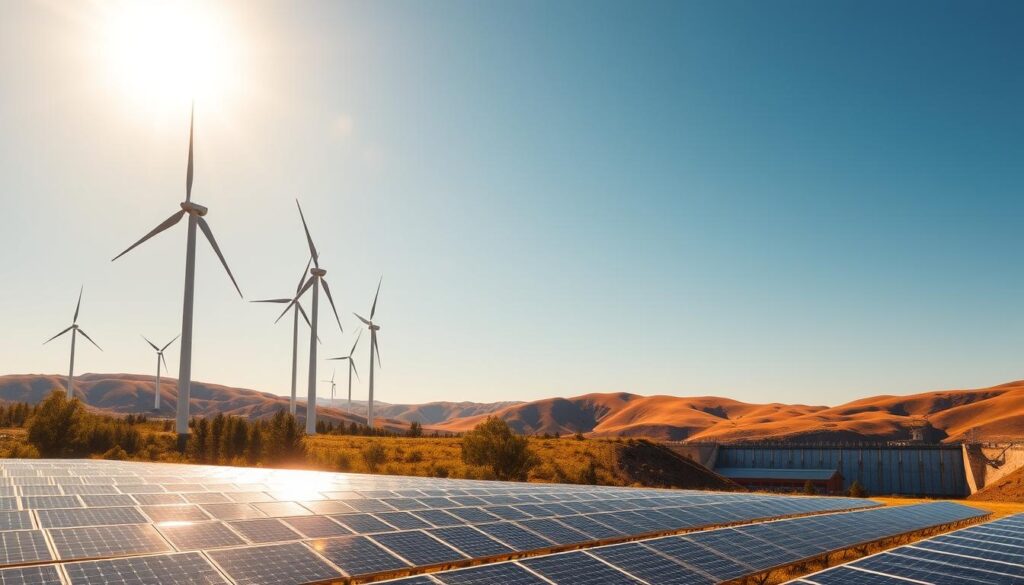
Sunlight energy, solar power, and renewable energy are all linked for a sustainable future. Solar systems can last 25 to 30 years and work well at 85% efficiency or better. As we move towards solar power, understanding its pros and cons is vital.
Key Takeaways
- Sunlight energy is a renewable source with many benefits, like less greenhouse gas emissions.
- Solar power is a clean and efficient way to make power, a good alternative to fossil fuels.
- Solar systems can last 25 to 30 years, a long-term energy solution.
- The cost for solar panel setup is high at first, but prices have dropped recently.
- Sunlight energy can save a lot on electricity bills over time, good for homes and businesses.
- Solar energy production can change a lot based on location and weather, but you can sell extra energy back to the grid.
Understanding Sunlight Energy Basics
Solar energy is a key part of renewable energy, a clean and sustainable choice over fossil fuels. It uses sunlight to make electricity or heat. Solar power technology has grown a lot over time.
Using solar energy helps cut down on carbon emissions and lowers electricity costs. In the U.S., solar energy use has soared. It went from about 0.06 trillion British thermal units (Btu) in 1984 to around 1,870 trillion Btu in 2022. This shows how solar energy is becoming more popular.

What is Solar Energy?
Solar energy comes from the sun’s rays. It’s captured by solar panels or collectors, turning sunlight into electricity or heat. The efficiency of these collectors depends on where you are, the weather, and the time of year.
How Solar Power Works
Solar power turns sunlight into electricity with photovoltaic (PV) cells. These cells are made from special materials that release electrons when sunlight hits them. This creates an electric current. Today’s PV cells can be up to 20% efficient.
Types of Solar Technology
There are different solar technologies, like PV systems, solar thermal systems, and concentrated solar power (CSP) systems. PV systems are the most common, using panels to make electricity. Solar thermal systems heat water or air, while CSP systems use mirrors or lenses to focus sunlight for heat or electricity.
In summary, knowing about solar energy basics is key to using sunlight for electricity or heat. By using solar power technology and renewable energy, we can lessen our dependence on fossil fuels. This leads to a more sustainable future.
The Evolution of Solar Power Technology
The solar power evolution has seen big steps forward in technology. Scientists have boosted the efficiency of solar panels and batteries. These technology advancements have made solar energy more practical and available.
Energy efficiency is key to solar power’s growth. Better solar panels have made solar energy cheaper. In 2020, the world added 125 GW of solar PV capacity, reaching 710 GW total.
Some important stats show solar power’s rise:
- Total installed solar capacity in Germany: 35 gigawatts
- Total installed solar capacity in China: 18 gigawatts
- Cost of solar photovoltaic energy: 11 cents per kilowatt hour

The future of solar power is bright. With ongoing technology advancements and better energy efficiency, solar power will be key in the shift to renewable energy.
| Country | Total Installed Solar Capacity (GW) |
|---|---|
| Germany | 35 |
| China | 18 |
| Italy | 17 |
Environmental Benefits of Solar Energy
Solar energy is great for the environment. It’s a better choice than using fossil fuels. By using the sun’s power, we can use less non-renewable resources. This helps make our planet cleaner and fights climate change.
Reduced Carbon Footprint
Solar energy is good for the planet because it cuts down on carbon emissions. Solar panels don’t pollute like coal or gas plants do. The US Department of Energy says sunlight can power all of humanity’s energy needs for a year.
Rapid Growth of Solar Energy
Solar energy is growing fast. Its share of global energy went from 0.06% to 1.11% from 2010 to 2019. In 2020, solar energy installations grew by 22%, showing more people are using it.
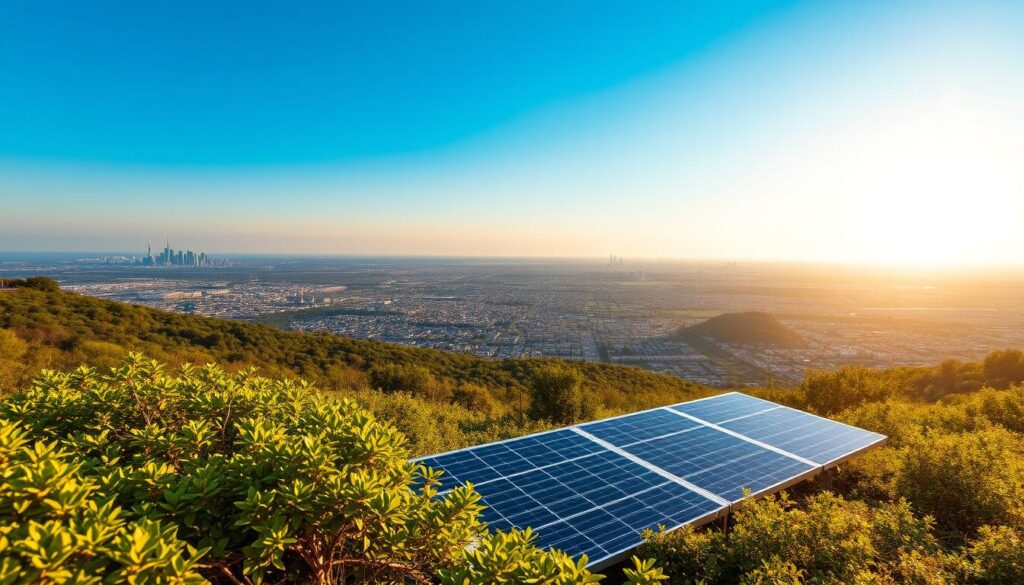
| Benefit | Description |
|---|---|
| Renewable Resource | Solar energy is a renewable resource with zero carbon emissions |
| Reduced Carbon Footprint | Solar energy reduces carbon emissions and contributes to a cleaner environment |
| Climate Change Mitigation | Solar energy helps mitigate climate change by reducing reliance on fossil fuels |
In conclusion, solar energy is very good for the environment. It cuts down on carbon emissions and helps fight climate change. As we move towards cleaner energy, solar energy will be key in creating a sustainable future.
Financial Implications of Solar Installation
Thinking about solar installation means looking at the money side. The upfront solar installation costs are big, but they save a lot of money later. Homeowners can cut their bills by $25,000 to over $110,000 over 25 years.
The financial benefits of solar are many. Homeowners save on electricity and boost their home’s value by about 4%. The average time to get back your money is 8 years in the U.S. Key benefits include:
- Lower electricity bills
- Higher home value
- 30% federal solar tax credit on costs
- Chance to make money from SRECs
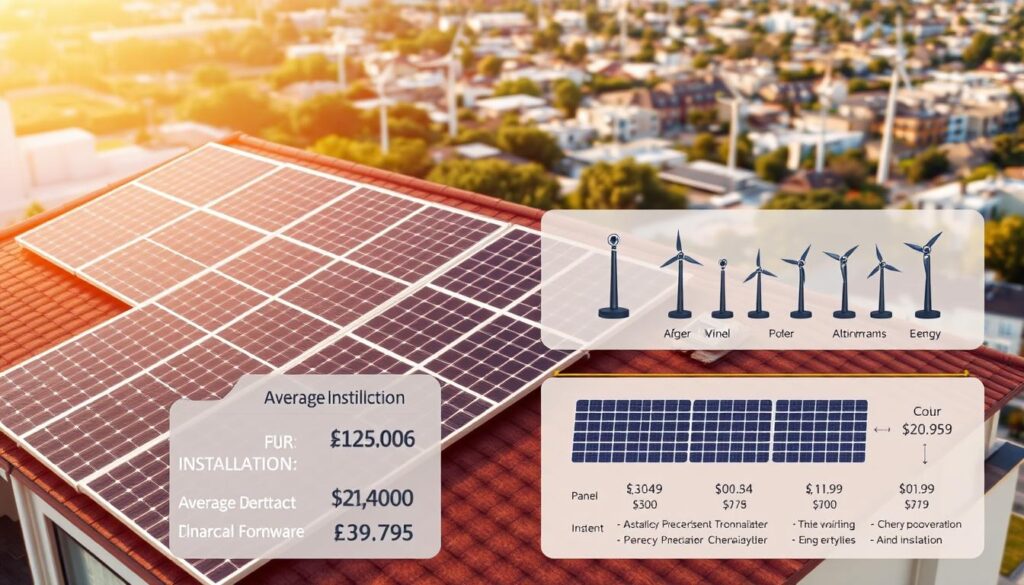
In the end, the financial benefits of solar far outshine the costs. With big energy savings and a higher home value, it’s a smart choice for homeowners.
Advantages and Disadvantages of Sunlight Energy in Modern Applications
Sunlight energy is becoming more popular in homes, businesses, and factories. It helps cut down on energy costs and supports green living.
Residential Benefits
Home solar systems offer many perks, like lower bills and less harm to the environment. Thanks to a 26% tax credit in the U.S., more people are choosing solar for their homes.
Commercial Applications
Business solar systems also bring big benefits, like saving money and boosting property value. Companies are investing in solar to save on energy and help the planet.
Some key benefits of solar energy include:
- Lower energy bills
- Less harm to the environment
- Higher property value
- Supports green living
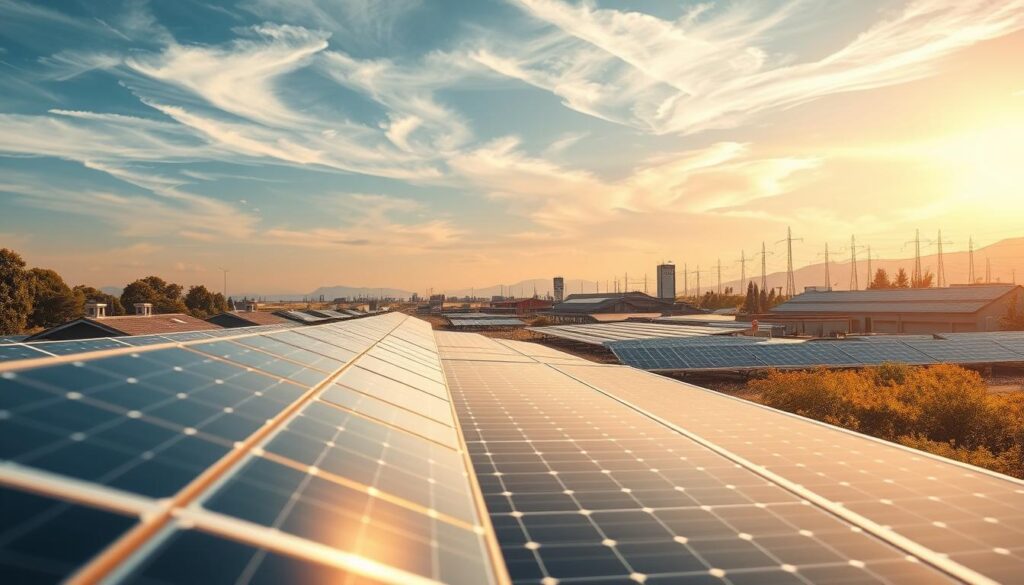
Industrial Uses
Solar energy is also used in making solar panels and equipment. This helps factories save on energy and support eco-friendly practices.
Initial Investment Requirements
The cost of starting a solar energy system is high. Solar panel costs and installation expenses are the main factors. But, think about the long-term savings and benefits.
Several things influence the initial investment. These include the solar panel type and quality, system size, and installation complexity. Also, financing options and tax credits can lower the upfront costs.
Here are important points to think about for the initial investment in solar energy systems:
- The price of solar panels and installation changes based on location and installer.
- Options like loans and leases can make the initial investment more manageable over time.
- Benefits like tax credits can cut down the initial investment, making solar energy more accessible.
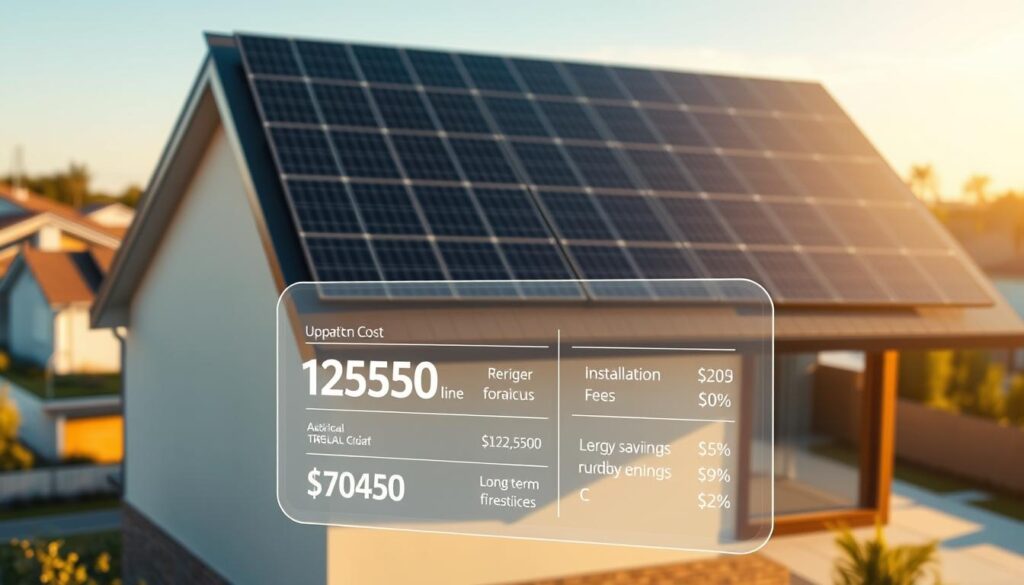
By carefully looking at the initial investment and thinking about long-term gains, people and businesses can decide if solar energy fits their needs.
Long-term Cost Benefits
Investing in solar energy offers big savings over time. Homeowners can cut their energy bills by up to £1,020 a year. The upfront cost of solar panels is worth it for the long-term savings.
The federal solar investment tax credit gives a 26% tax credit for solar installations. This makes solar panels more appealing for saving on energy bills. The Smart Export Guarantee (SEG) also pays for extra energy sold back to the grid, encouraging more people to use solar energy.
Energy Bill Reduction
Solar energy cuts down on energy bills by using sunlight to make electricity. With most homes using about 3,000 kilowatt-hours of electricity yearly, solar panels can make a big difference. Some homeowners even save up to 50% on their bills.
Government Incentives
Government incentives, like the federal solar investment tax credit, help lower the cost of solar panels. This tax credit can cover up to 26% of the system’s cost. The SEG also rewards homeowners for selling extra energy back to the grid, making solar energy even more appealing.
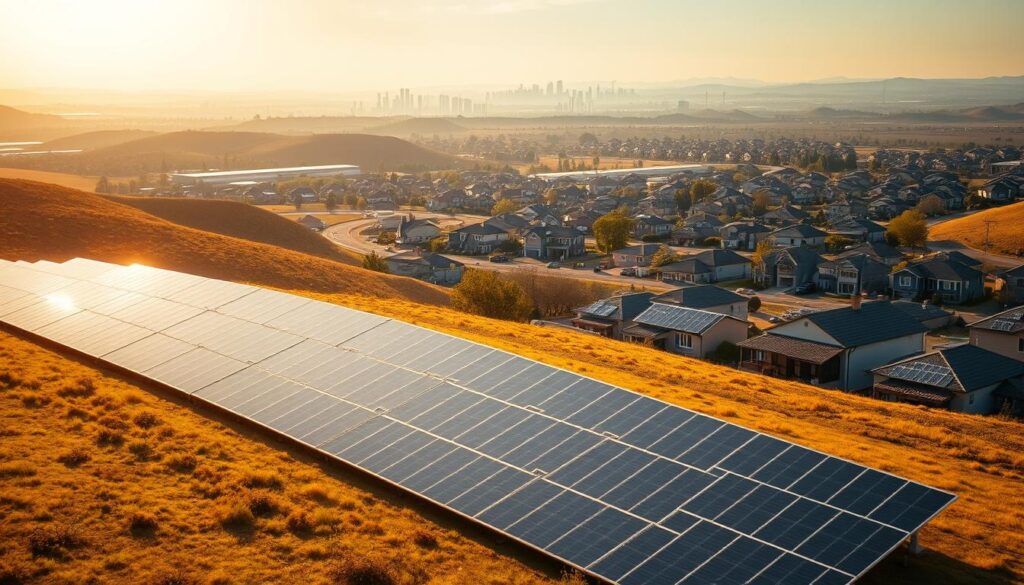
| Year | Energy Bill Reduction | Government Incentives |
|---|---|---|
| 1 | £500 | £1,000 |
| 5 | £2,500 | £5,000 |
| 10 | £5,000 | £10,000 |
In summary, solar energy brings long-term savings and government help. With the right incentives and a good solar panel system, homeowners can save thousands. This helps the planet and saves money too.
Maintenance and Durability Considerations
Solar energy systems are built to last, needing little solar panel maintenance. They can work for 25 to 30 years, keeping 80% efficiency after 25 years. This makes solar energy a green choice for reducing environmental harm.
Keeping your solar panels in top shape is key. This means cleaning them, checking for damage, and making sure all connections are tight. With solar panel maintenance, you can make your system last longer and get more value from it.
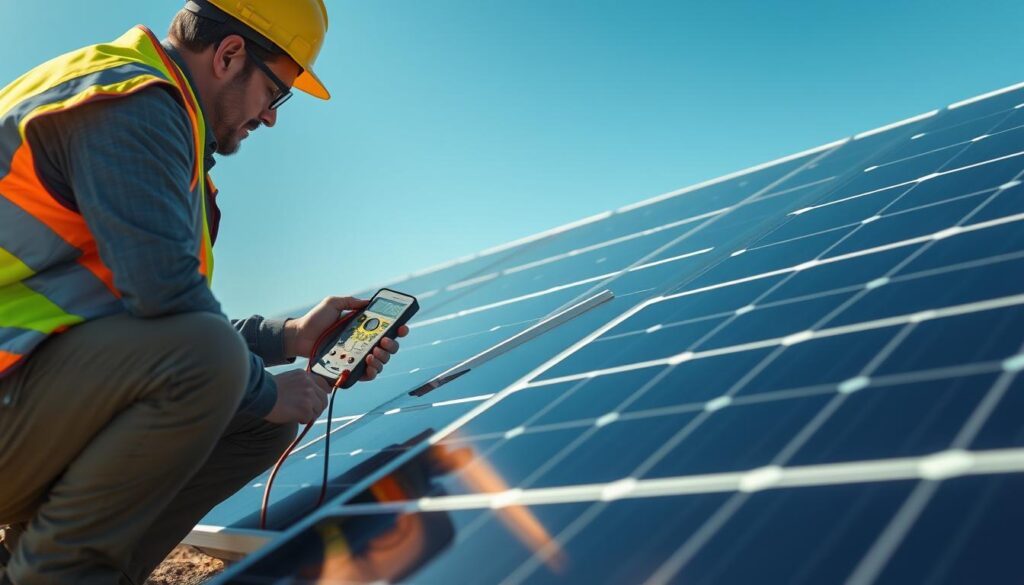
Important things to think about for solar panel maintenance and durability are:
- Regular cleaning and inspection of the panels
- Checking for damage or wear and tear
- Ensuring all connections are secure and functioning properly
By following these tips and doing regular solar panel maintenance, you can keep your system running well for many years.
Space and Installation Requirements
When thinking about solar energy, it’s key to check the space needed for installation. Not every roof can hold solar panels, and sometimes yards need extra space. A detailed roof check is vital to see if rooftop installation works. This check looks at the roof’s size, condition, and any things that might block the solar panels’ work.
There are different ways to install solar energy systems, and putting them on the ground is one option. Ground systems need open land, and they take up a lot of space, usually 100-400 square feet per kilowatt. The type and how well solar panels work also affect how much space they need.
Key Factors to Consider
- Roof size and condition
- Obstructions, such as trees or buildings
- Space requirements for ground installation
- Type and efficiency of solar panels
Understanding these points is important for a good solar energy setup. By looking at space needs and installation choices, people can make smart decisions. This ensures a smooth move to using renewable energy.
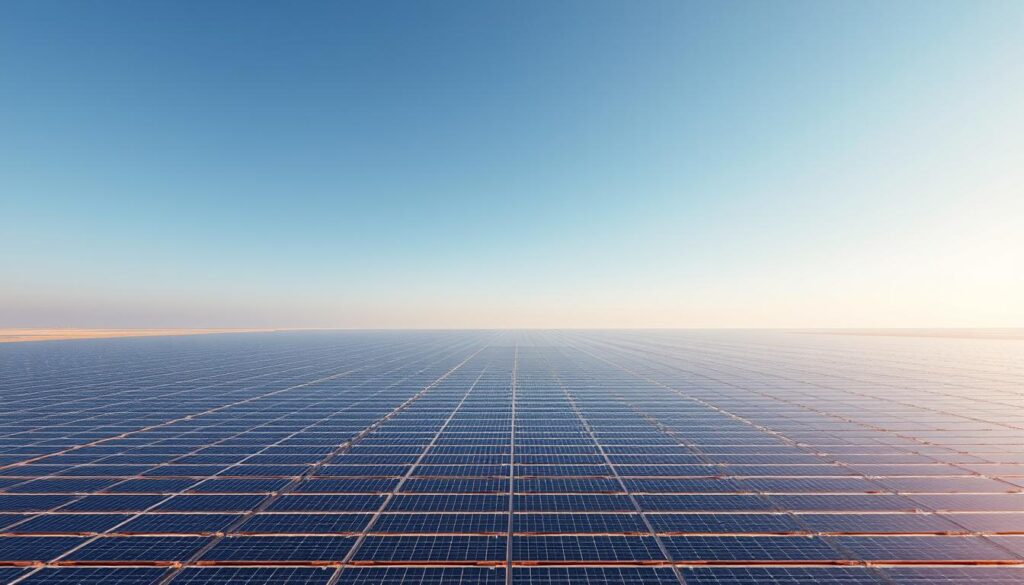
Weather Dependency Challenges
Solar energy production is heavily influenced by weather conditions, with weather dependency being a significant challenge. Rainy seasons can impact solar energy efficiency because of less sunlight. Yet, rainy seasons also clean solar panels naturally, which can improve their efficiency.
Some key factors to consider when it comes to weather dependency and solar energy production include:
- Raindrops on solar panels can reflect or partially block sunlight, reducing energy conversion efficiency
- Cooler temperatures during rainy seasons can lead to improved solar panel performance, as efficiency can drop significantly at high temperatures
- Extreme storm conditions during the rainy season can threaten the physical integrity of solar panels and their structures
To lessen the impact of less sunlight, new solar technology and energy storage solutions are being developed. Energy storage systems, like batteries, store extra energy made when it’s sunny. This way, we can use it when it’s rainy or cloudy.
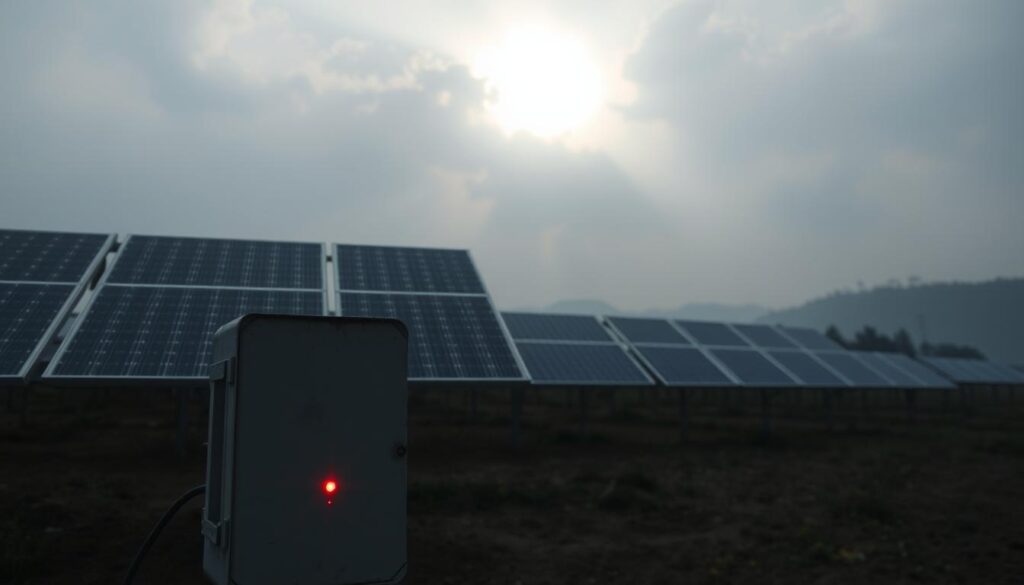
By tackling the challenges weather poses and finding effective solutions, solar energy can become more reliable. This helps us use less non-renewable energy and moves us towards a greener future.
| Weather Condition | Impact on Solar Energy Production |
|---|---|
| Rainy Seasons | Reduced sunlight intensity, but natural cleaning of solar panels |
| Cloudy Days | Reduced energy conversion efficiency |
| Extreme Storm Conditions | Threat to physical integrity of solar panels and structures |
Energy Storage Solutions
The world is moving towards renewable energy, and energy storage is key. Solar energy needs good storage to keep power stable. Battery technology has improved a lot, making solar energy systems better.
Energy storage is very important. It lets us save extra energy from solar panels for when we need it. This is great for homes and businesses using solar power. Having ways to connect to the grid is also important. It helps move energy smoothly between solar systems and the grid.
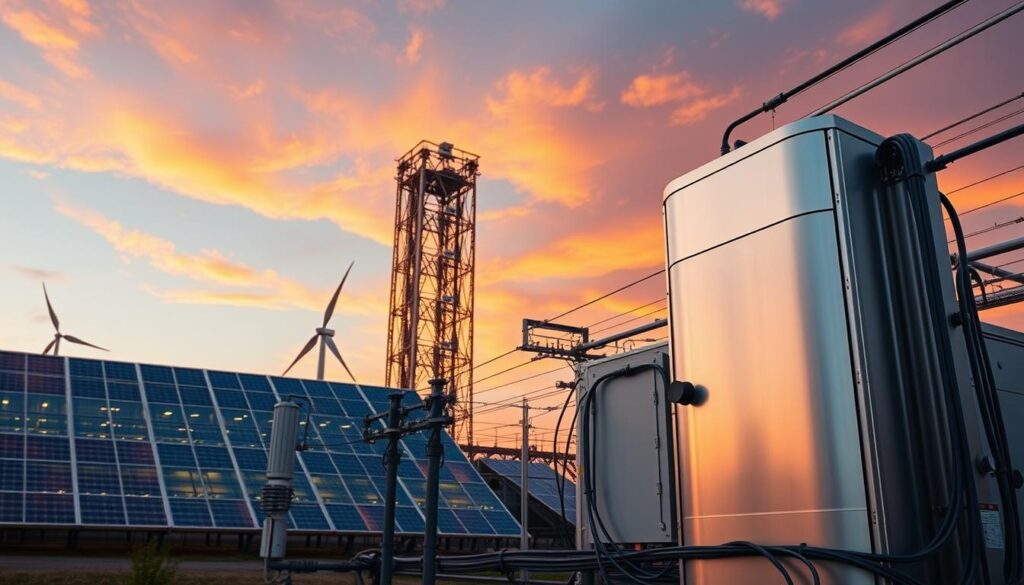
- Reduced energy bills: Energy storage systems can help reduce energy bills by storing excess energy generated by solar panels during the day for use during periods of low energy production.
- Increased energy independence: Energy storage systems can provide a reliable source of power, even during periods of low energy production, increasing energy independence.
- Improved grid stability: Energy storage systems can help regulate grid frequency, improving grid stability and reducing the strain on the grid during periods of high energy demand.
In conclusion, energy storage solutions like batteries and grid connections are vital for solar energy. As we move to more renewable energy, the need for good storage will grow.
Impact on Property Value
Installing solar energy systems can greatly increase your property’s value. Homes with solar panels tend to be more valuable than those without. This is because solar panels are viewed as a smart investment. They save money on energy in the long run and reduce our need for fossil fuels.
Solar energy systems bring many benefits to real estate. They make a home more appealing to buyers, making it more desirable. Solar panels also offer a reliable energy source and can lower energy bills. This makes homes with solar panels more valuable when it’s time to sell.
Some key benefits of solar energy systems for property value include:
- Increased property value
- Improved appeal to buyers
- Long-term energy savings
- Reduced reliance on non-renewable energy sources
The cost of a residential solar system varies, but it’s often between $2.70 and $3.25 per watt. The current federal tax credit can cut this cost by 30%. This makes solar energy a smart choice for homeowners, boosting property value.

Homes with solar panels are more appealing to buyers, thanks to their reliability and energy savings. The payback period for solar systems ranges from 5 to 15 years. As demand for green energy grows, the value of solar systems in real estate will too.
| System Size | Average Cost |
|---|---|
| 5kW | $13,500 – $16,250 |
| 6kW | $16,200 – $19,500 |
| 10.8 kW | $27,300 – $33,000 |
Geographic Location Factors
When we talk about solar energy, geographic location is key. The amount of sunlight changes a lot by region. This affects how well an area can use solar energy.
Places with lots of sunlight, like areas with over 5 kWh/m²/day, are best for solar power. This is because they get a lot of sun all year.
Climate and sunlight hours also matter for solar panels. Places with more sun can make more energy. For example, the Southwestern United States is great for solar energy.
But, areas with less sun need more panels to make the same amount of energy. This is because they get less sunlight.
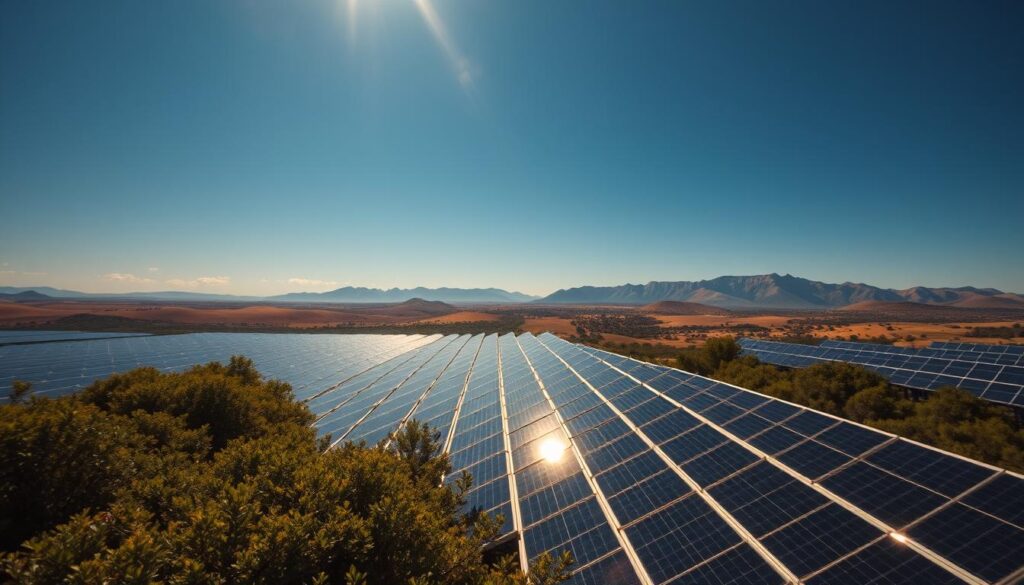
It’s important to know how geographic location affects solar energy. This helps people and businesses decide if solar energy is right for them. It also helps them use the sun’s power better for a greener future.
| Region | Sunlight Hours | Solar Energy Potencial |
|---|---|---|
| Southwestern United States | Over 300 sunny days per year | High |
| Pacific Northwest | Around 152 sunny days annually | Low |
Future of Solar Technology
The future of solar technology is bright. Emerging innovations and efficiency improvements are making solar energy more viable. As we move towards renewable energy, solar will play a big role in reducing fossil fuel use.
New advancements in solar tech include better battery storage, smart grids, and solar panels built into buildings. These changes will make solar energy systems more efficient and appealing to everyone.
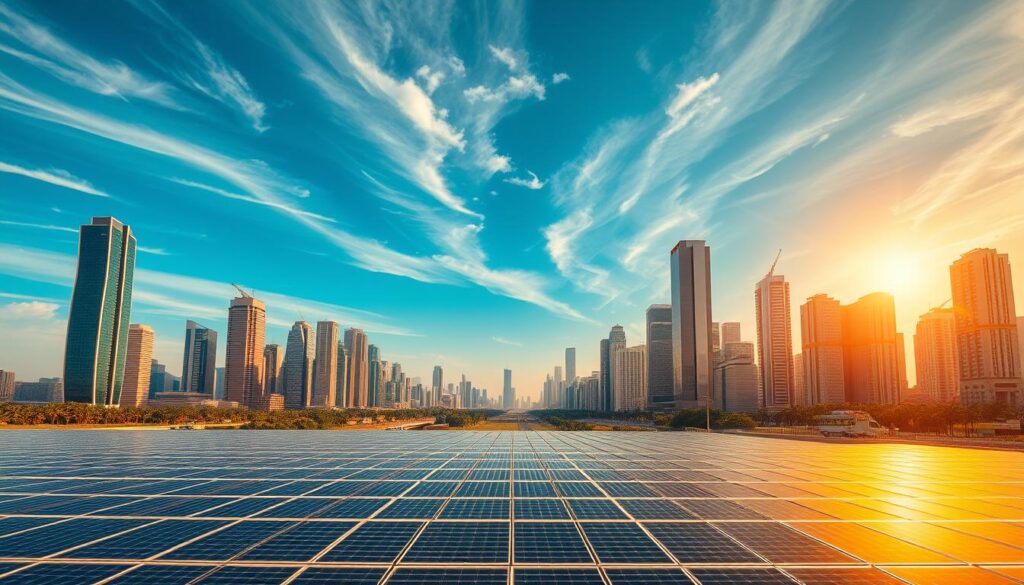
Researchers are also working on making solar panels more efficient. They aim to get more electricity from the same sunlight. This is happening through new materials and technologies like bifacial solar panels and perovskite solar cells.
Emerging Innovations in Solar Technology
- Advancements in battery storage
- Smart grids and energy management systems
- Building-integrated photovoltaics
Efficiency Improvements in Solar Technology
As solar tech evolves, we’ll see even more innovative solutions. These will make solar energy even more attractive for those wanting to cut carbon emissions and save on energy costs.
Common Misconceptions About Solar Energy
There are many myths about solar energy that might stop people from using it. One myth is that solar panels don’t work on cloudy days. But, solar energy misconceptions like this are being fixed by new technology. Now, solar panels can make 10%-25% of the energy they make on sunny days, even in shade or on cloudy days.
Another myth is that solar panels cost too much. It’s true that buying solar panels can be expensive at first. But, the price has dropped by about 30% from 2009 to 2015. Plus, facts like the Solar Investment Tax Credit (ITC) and the Feed-in Tariff (FiT) scheme can help save money in the long run. Here are some important solar energy facts:
- Solar panels can increase a property’s value by an average of 4.1%.
- Modern solar panels last for 25 to 30 years.
- Solar energy is now cheaper to make than electricity from coal worldwide.
It’s key to know the truth about solar energy to make smart choices. By understanding both the good and bad, we can help the planet and save on energy bills.
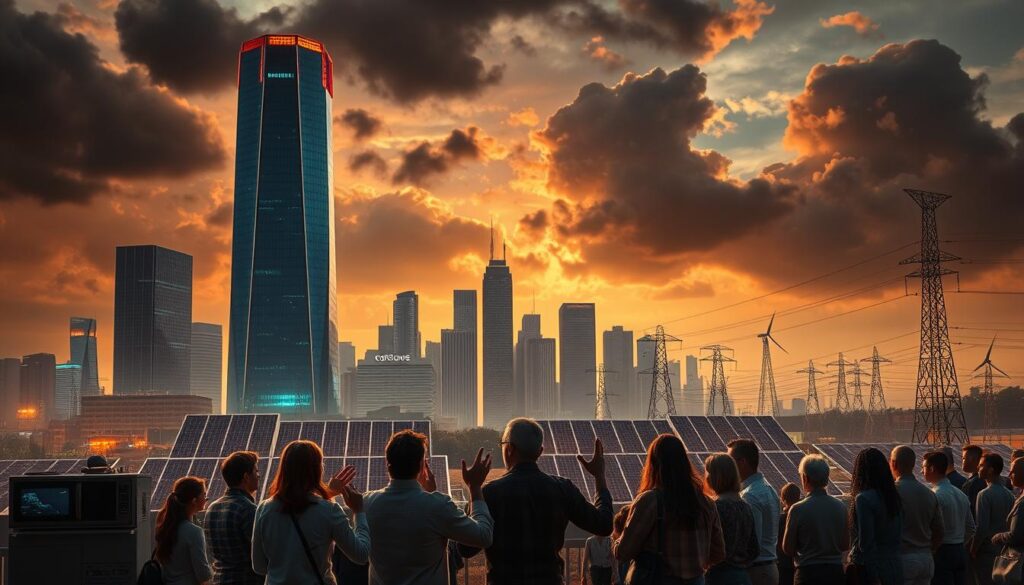
| Myth | Fact |
|---|---|
| Solar panels do not work on cloudy days. | Solar panels can generate energy on cloudy days, but not as much. |
| Solar panels are too expensive. | The cost of solar panels has gone down a lot, and the ITC can help with the upfront cost. |
Comparing Solar with Other Renewable Energy Sources
Looking at renewable energy options, it’s key to know the good and bad of each. A comparison helps make smart choices. Solar, wind, and hydroelectric power are top picks against fossil fuels.
Solar energy is known for being easy to use and needing little upkeep. Yet, wind and hydroelectric power have their own perks. For example, wind turbines can be cheaper in places with steady winds.
Wind Energy Comparison
Wind energy works well in areas with good wind. Though wind turbines need more care than solar panels, they can make a lot of power. Some wind energy benefits are:
- Lower cost per kilowatt-hour in areas with strong winds
- Ability to generate electricity in remote locations
- Creation of jobs in the wind energy sector
Hydroelectric Power Comparison
Hydroelectric power is very efficient, over 90%. But, it needs a big investment in things like dams. Hydroelectric power’s benefits are:
- High energy conversion efficiency
- Reliability and consistency of energy output
- Low operating costs
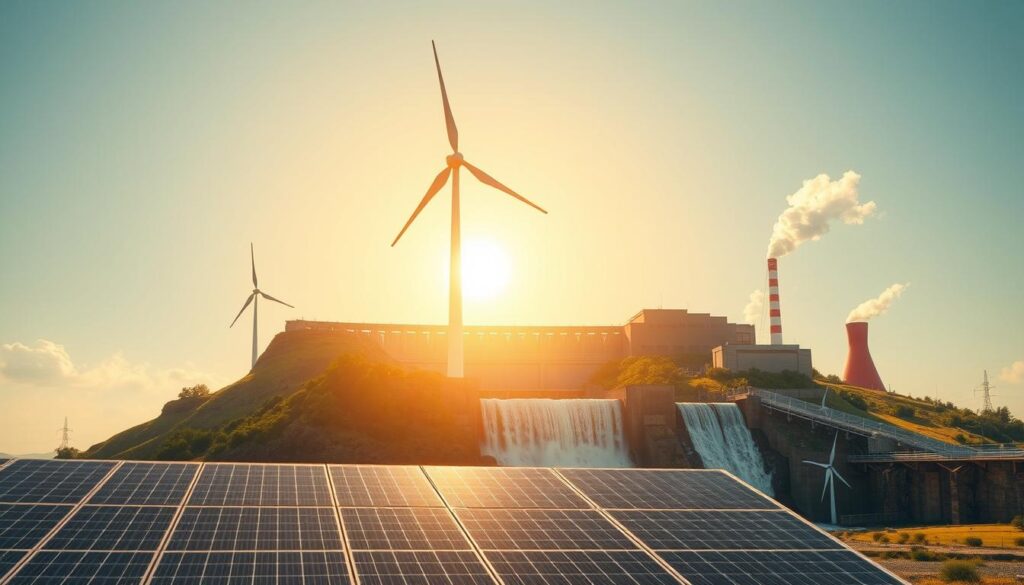
In summary, each renewable energy has its own pros and cons. A detailed comparison helps pick the right one for your needs.
Conclusion
Solar energy is a key player in our sustainable future. It can cut electricity bills by up to 50%. Plus, federal tax credits help cover a big part of the cost, making it affordable for many.
While solar power faces challenges like weather and installation needs, its long-term savings and environmental benefitsare huge. New tech in batteries and grid systems is making solar power more reliable and accessible. This opens doors for homes, businesses, and industries.
The solar industry is growing fast, about 20% each year. Choosing solar energy helps us create a cleaner, greener world. It reduces our carbon footprint and fights climate change. Going solar is a big step towards a brighter, more independent energy future.
FAQ
What is solar energy?
Solar energy comes from the sun’s rays. It can be turned into electricity or heat using solar tech.
How does solar power work?
Solar power uses special cells to catch the sun’s energy. This energy is then turned into electricity to power homes and businesses.
What are the different types of solar technology?
There are three main types of solar tech. These are photovoltaic (PV) systems, concentrated solar power (CSP), and solar thermal systems. Each has its own uses.
How has solar power technology evolved over time?
Solar tech has made big strides. It’s now more efficient and cheaper. New materials and ways to make it have helped a lot.
What are the environmental benefits of solar energy?
Solar energy is great for the planet. It cuts down on carbon emissions and uses clean energy. It helps fight climate change too.
What are the financial considerations for installing solar energy systems?
Thinking about solar energy costs includes the upfront price and savings on bills. There are also government perks and how long it takes to pay off.
What are the advantages and disadvantages of solar energy in modern applications?
Solar energy has many benefits, like saving money and being green. But, it needs space, works best in good weather, and needs upkeep.
What are the key factors affecting the long-term cost benefits of solar energy?
The long-term savings of solar energy depend on bill cuts, government help, and how fast you get your money back.
How durable are solar energy systems, and what maintenance is required?
Solar panels last a long time. But, they need regular care to work their best.
What are the space and installation requirements for solar energy systems?
Solar systems need the right space and setup. This includes checking your roof and ground options.
How do weather conditions impact the efficiency of solar energy production?
Bad weather can lower solar energy output. But, using batteries and connecting to the grid can help.
What energy storage solutions are available for solar energy systems?
Solar systems can use batteries or connect to the grid. This makes them more reliable and efficient.
How can solar energy systems impact property value?
Solar systems can boost your home’s value. They’re good for selling and make your home more valuable.
What geographic factors influence the solar energy’s feasibility?
Where you live affects solar energy’s use. Sunlight and local rules are key factors.
What emerging innovations and efficiency improvements are there in solar technology?
Solar tech is getting better. New ideas and improvements are making it even more appealing.
What are some common misconceptions about solar energy?
There are myths about solar energy. It’s important to know the truth to encourage using it.
How does solar energy compare to other renewable energy sources?
Solar energy has its own strengths and weaknesses. It’s good to compare it with wind and water power to see all the options.